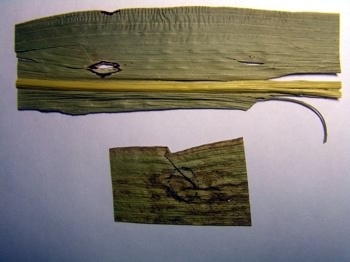Diseases
Septoria spp. - Septoria Leaf Spot of Maize
Systematic position.
Class Ascomycota, subclass Dothideomycetidae, order Mycosphaerellales, family Mycosphaerellaceae, genus Septoria. Several species of Septoria are known: Septoria maydis f. major, S. zeicola, S. zeina, S. maydis, S. zeae.Biological group.
Hemibiotroph.Morphology and biology.
In Russia, only two species of Septoria are known, S. maydis and S. zeae. S. maydis causes an appearance of long spots with dark edge along leaf veins. Globe-shaped (about 100 mkm in diameter) pycnidia are formed under epidermis of damaged tissue. Conidia are cylindrical, with three and more septae. They are colorless, having rounded edges. S. zeae causes the same disease symptoms, but its pycnidia project from tissue as nipple-like stomata. Pycnidia are globe-shaped, brown, 90-130 mkm in diameter. Conidia are cylindrical, colorless or somewhat greenish, with seven septae.Distribution.
S. maydis is spread in the Caucasus and in Ukraine; S. zeae is known in the Far East, Ukraine, and Byelorussia.Ecology.
High humidity is favorable for this disease.Economic significance.
Plant protection measures include sowing of resistant hybrids, and plowing-in of plant debris.Related references:
Nemlienko F.E. 1957. Diseases of maize. Moscow: Sel.khozgiz. 230 p. (in Russian).Teternikova-Babayan D.N. 1987. Fungi of the genus Septoria in the USSR. Yerevan: Academy of Sciences of Armenian SSR, 479 p. (in Russian).


